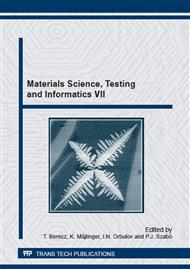p.201
p.207
p.213
p.219
p.227
p.233
p.239
p.247
p.253
The Modelling of Crater Wear in Cutting with TiN Coated High Speed Steel Tool
Abstract:
The flow zone of the chip in contact with the tool reaches a high temperature in cutting. According to chip hardening experiments α-γ transformation may occur in steel, so the tool is in contact with a high-temperature γ phase at high pressure. The microscopic examination of worn surfaces showed that the degradation of the tool is the result of adhesive/abrasive and thermally activated processes, therefore both friction length and temperature must be taken into consideration in the modelling of crater wear. Wear rate can be described by a non-linear autonomous equation. TiN coating, which increases tool life in high speed steel, changes and slows down the wear of the tool. The activation energy of wear can be calculated from the constants of the wear equation determined by cutting experiments. The deoxidation products to be found in the workpiece in cutting may form a protective layer on the TiN layer that blocks or slows down wear.
Info:
Periodical:
Pages:
227-232
Citation:
Online since:
February 2015
Authors:
Keywords:
Price:
Сopyright:
© 2015 Trans Tech Publications Ltd. All Rights Reserved
Share:
Citation:


